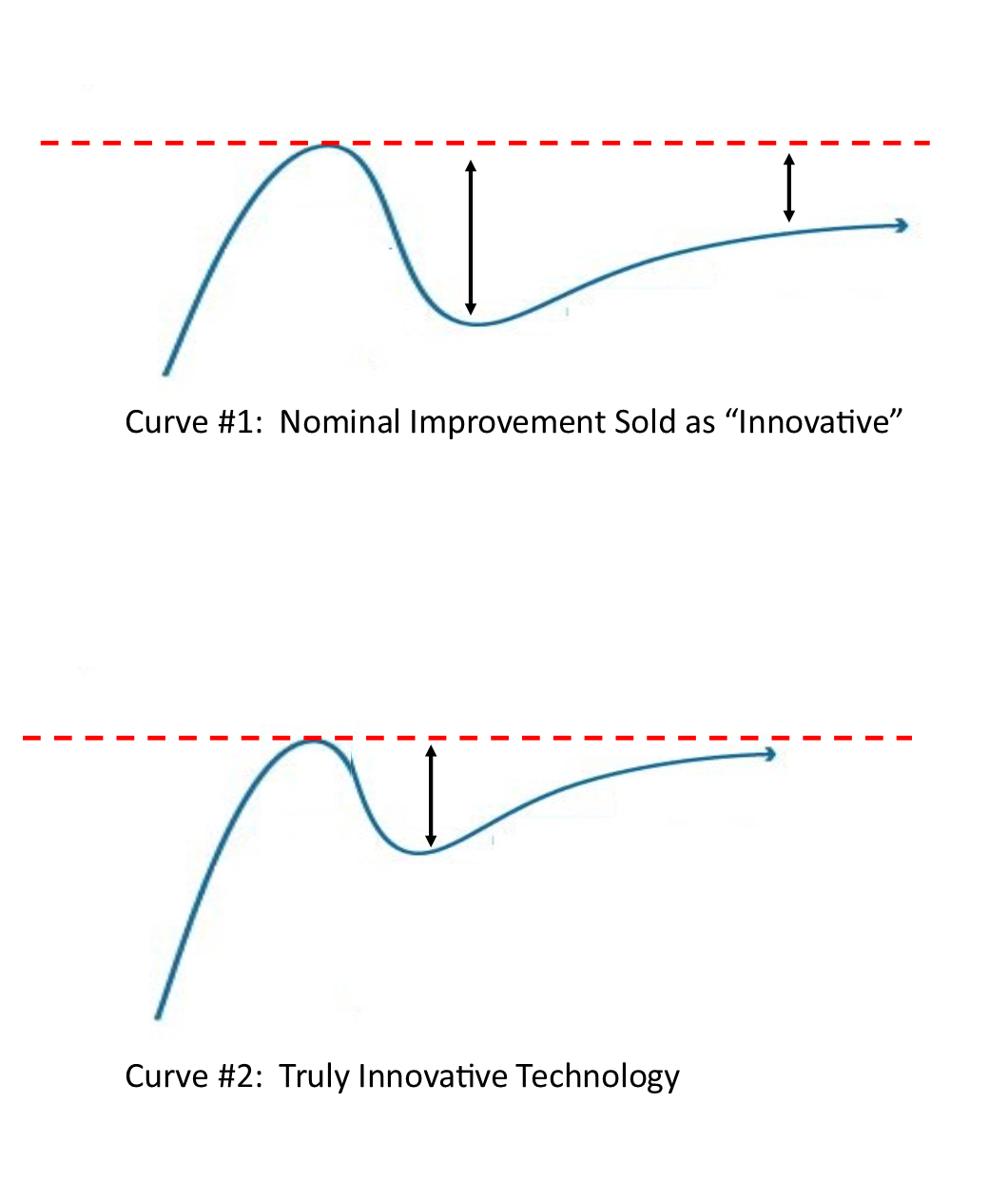Expectations and Innovation

If you’re like me at all, you received dozens of emails before InfoComm15 touting game-changing, disruptive, and innovative new technologies. Given this cacophony of infinite hyperbole, you would assume that innovation at InfoComm this year was in full effect. I mean “WOW” was even the tagline this year for Pete’s sake.
However, now that the dust has had some time to settle, did anything on display dramatically change our AV world? There are differing viewpoints on innovation at the show, with this exchange in Commercial Integrator being a prominent example, (an exchange I heard may have continued at the CECI Summit last week as well). But even the proponents of innovation at the show don’t seem to be pointing out major shifts, but rather small migrations in existing technologies and methodologies.
I’m not going to insert myself into the finer points of those arguments at this point, although I have asked whether product introductions were Innovative or InfoCommon as well in the past.
Instead, I am going to two different questions altogether. Is it fair or even realistic to expect major innovation every year in the first place? As a follow up to that, what is the negative impact of marketing departments continually overselling small improvements in technology as major breakthroughs?
First of all, the mere nature of innovation involves “fundamental change” and not just improvement or window dressing. Innovation is followed by a much longer period of actual integration and implementation before a new innovation can then be fully developed and introduced. Many times parallel technologies may feed off of innovation in other areas, so you may see clusters of innovation all at once, but typically that sea of change calms for a while afterwards. It takes time to change the foundation again so true innovation is intuitively not as common as the hype would have you believe.
The Gartner Group has done a study on what they call “The Hype Cycle” and have even created a graph to illustrate what happens when a new technology is introduced.
To be fair,we are not the only industry guilty of overdoing it in the marketing arena. I just read another article asking marketers to stop it with the exclamation points already as the overuse of them is gutting marketing messages of their true value and actually decreasing the impact of the message itself. They include a great piece by Louis C.K. that I couldn’t help but share here:
“As humans, we waste the s — t out of our words. It’s sad. We use words like ‘awesome’ and ‘wonderful’ like they’re candy. It was awesome? Really? It inspired awe? It was wonderful? Are you serious? It was full of wonder? You use the word ‘amazing’ to describe a g-d sandwich at Wendy’s. What’s going to happen on your wedding day, or when your first child is born? How will you describe it? You already wasted ‘amazing’ on a f — g sandwich.”
It’s the same when we overuse words like innovative, game-changing, and disruptive.
I took Gartner’s curve and drew some conclusions on what true innovation would look like in this “hype cycle”. A truly innovative technology would have a hype curve with a much shallower trough of disillusionment and a quicker path through enlightenment to productivity. The gap between the initial peak of expectations and final plateau of productivity would also be much narrower if not non-existent. True innovation does not leave the end-user at a deficit between their expectations and the realized utility. It doesn’t unduly extend the time between the adoption of a new technology and its utility, waiting for the rest of the ecosystem to catch up. See the two curves below.
The question then becomes
“How many times can we go back to the well with the same message and have any true impact on the buying behavior of our customer?”
Consider 4K/UHD. We introduce the display technology as game-changing without any content, proper dynamic range, color space, frame rate, cabling, or infrastructure required to make it any good. Then we scream 4K each time the next piece if the puzzle is introduced. Each time the expectations of the buyer get less and less, which means our ability to drive product sales decreases. Eventually, after an extended period of time and several hype curves the consumer’s expectations are so small that they are inevitably met and we claim victory? I illustrated this below as well.
You can apply the graph above to 3D as well, a technology we have hyped repeatedly with little fulfillment of its promise, and one we are about to hype again with 4K/UHD and “1080p per eye” and also with laser projection and more uniform and consistent brightness.
We need to be happy with selling the actual merits of technology and the improvements we make to our products and stop feeling compelled to overstate their ability to change the world as we know it.
I actually blame the MVP theory of product development somewhat for the trends in technology marketing we see today.
If you’re not familiar with MVP
“A Minimum Viable Product is the smallest thing you can build that delivers customer value (and as a bonus captures some of that value back).”
MVP is an amazing theory for product development in that it is designed to “allow a team to collect the maximum amount of validated learning about customers with the least effort.” This means that you can go to market with a technology in a way that allows the sales of that initial technology and the feedback from early adopters to build out the features of that product more and more to address a wider and wider market.
The problem is that marketers are using the MVP incorrectly in their marketing strategy. They are given a base technology and then they sell the long term advantages of that technology despite the short term gap in the actual ability to deliver on them. They are selling the minimum viable product as if it were the full featured future version.
I love how some are using “future proof” when referring to 4K/UHD as a way to get their clients to buy a technology they have no need for today. Selling something as “future proof” pretty much defines the technology as something you don’t need now but may need later. It’s a terrible term to begin with, and for those selling 4K and UHD this way, have fun explaining that to your clients when you are pitching 8K and UHD-2 in a couple more years.
We can use MVP as a product development strategy and then market products in a way that capitalizes on that and reduces the hype curve as to not poison the well when its time to send the bucket down for the next dip.
Let’s take the 4K/UHD for example again. There was a much better way to take that product to market in a way that fulfilled customer expectations and drove initial panel sales without desensitizing consumers to future 4K/UHD improvements.
Most industry experts agree the best use for 4K/UHD today is for displaying 4 discrete 1080p sources on the same display in full pixel for pixel resolution. Bringing these to market as multi-source displays may have been a much better strategy as they would have met and exceeded all expectations. Of course added bonuses could be to scale to full screen or to play custom 4K/UHD content, but the expectation wouldn’t have been stated as “4K makes everything look better” when in reality, it may make some things look even worse.
Then when 4K/UHD content started to develop more, you could go to the well again promoting the next application ready for use. You would go through the same iterations of hype curves shown above, but the message wouldn’t be UHD! or 4K! every time and the consumer then stays receptive to each new round.
(For anyone about to argue that 4K/UHD has been growing in adoption, I challenge you to adjust 4K/UHD sales for the natural increase in total adoption of flat panels and then find a way to adjust for all the 4K/UHD sales that would have been made anyway if the displays were all still 1080p. How many customers that were NOT in the market for a 1080p display or already had 1080p displays in existing applications went out and bought a new display just because it was UHD? That total is in reality a better representation of the actual impact of 4K/UHD and represents a fraction of those sales to date.)
My ultimate conclusion here, and you can feel free to disagree in the comments if you feel so inclined, is that it is unrealistic to expect innovation in every category every year. It is also a bad idea to sell anything less than innovation as such, as it has a long term negative effect on the adoption of technology, as well as on the reputations of our companies. It’s the tech equivalent of crying wolf and we all know how that story ended.
We should be marketing the incremental advantages directly to the markets and people they apply to, and as those advantages increase to gain wider appeal we will find that our next attempts to generate interest and adoption don’t fall on deaf ears. Better yet, when innovation does happen, and it will over and over again, the response will be amazing.





